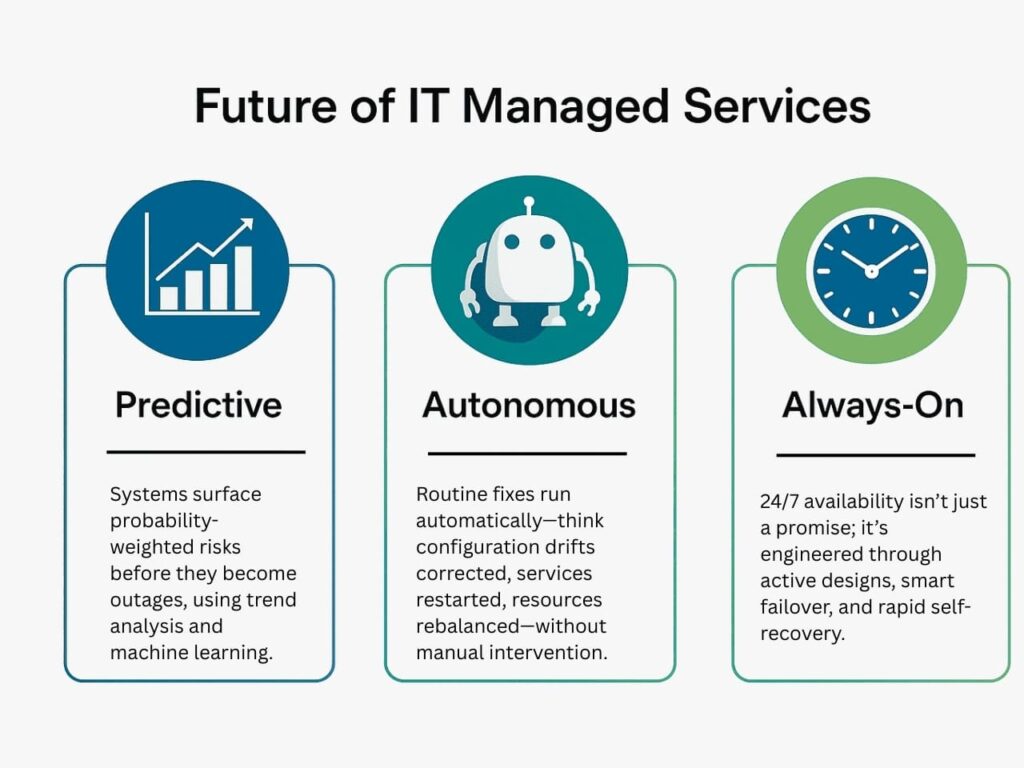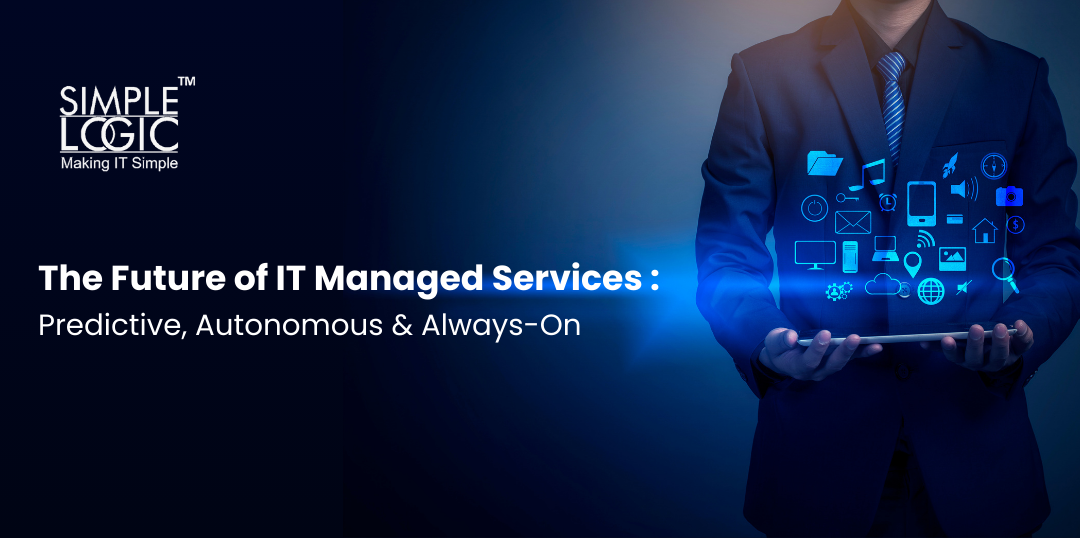Key Takeaways
- IT managed services are moving from reactive support to predictive, autonomous, and always-on operations that reduce downtime and cost while improving user experience.
- AI, analytics, and automation enable self-healing infrastructure, proactive risk prevention, and round-the-clock service quality.
- A staged adoption path—observability first, automation second, autonomy last—keeps risk low and ROI visible at every step.
- Success depends on governance, security, data quality, and clear service SLOs, not just tools.
- Simple Logic IT delivers a partner-led approach: discovery and TCO model, reference architecture, pilot, scale-out, and continuous optimisation.
- Expect measurable outcomes: 40–60% faster incident resolution, fewer outages, better compliance reporting, and predictable costs.
- This is not a tooling swap. It’s an operating model upgrade designed for hybrid and multi-cloud realities.
Table of Contents
- Introduction
- What “Predictive, Autonomous & Always-On” Really Means
- Why this shift is happening now
- Predictive IT Managed Services – Looking Ahead
- Autonomous Managed Services – The Self-Healing Enterprise
- Always-On Managed Services – The New Standard
- Comparison: Predictive vs Autonomous vs Always-On IT Managed Services
- Core Building Blocks
- Architecture at a Glance
- Adoption Roadmap: Turning Vision into Action
- Cost and ROI: Where the Savings Come From
- Security and Compliance: No Trade-offs
- Common Pitfalls and How to Avoid Them
- How Simple Logic IT Helps
- Conclusion
- FAQ: Practical Questions Leaders Ask
Introduction
The way organisations managed IT has shifted dramatically over the last decade. Businesses no longer want reactive support that only addresses issues after they occur. Instead, they expect technology that predicts problems before they arise, resolves them autonomously, and runs without interruption.
This is the foundation of the future of IT managed services: predictive, autonomous, and always-on. By 2025, these services are not just “nice-to-have”—they are essential for businesses to stay competitive, compliant, and resilient.
In this blog, we’ll explore what this transformation means, how technologies like AI and cloud are driving it, and how Simple Logic IT supports companies in navigating this shift.
What “Predictive, Autonomous & Always-On” Really Means
Here’s the thing: Traditional managed services respond to tickets. The model works, but it’s slow, people-heavy, and prone to repeat incidents. The future raises the bar:
- Predictive: Systems surface probability-weighted risks before they become outages, using trend analysis and machine learning.
- Autonomous: Routine fixes run automatically—think configuration drifts corrected, services restarted, resources rebalanced—without manual intervention.
- Always-On: 24/7 availability isn’t just a promise; it’s engineered through active designs, smart failover, and rapid self-recovery.
This approach serves outcomes executives actually care about: fewer incidents, faster recovery, consistent compliance, and lower total cost of ownership.

Why this shift is happening now
- Hybrid by default: Most enterprises run a mix of data centre, private cloud, and public cloud. Manual coordination doesn’t scale.
- Complexity shock: More services, more dependencies, more APIs. Observability and automation are no longer optional.
- Talent gaps: Skilled engineers are scarce; automation protects capacity.
- Risk and regulation: Continuous compliance monitoring is easier to automate than audit later.
- Experience is king: Business teams expect apps to be available and fast, regardless of where they run.
Predictive IT Managed Services – Looking Ahead
What Predictive Services Mean
Predictive services use advanced analytics and AI models to anticipate failures before they happen. For example:
- Forecasting hardware failures by analysing usage and heat signatures.
- Detecting abnormal network traffic before it becomes a security breach.
- Anticipating capacity needs to avoid resource bottlenecks.
Benefits of Predictive Services
- Reduced downtime through proactive intervention.
- Smarter resource allocation by forecasting demand.
- Improved security posture with early threat detection.
- Cost savings from avoiding unplanned outages.
Industry Examples
- Banks predicting ATM hardware failures before breakdowns.
- Hospitals monitoring medical devices for early fault detection.
- Retailers forecasting traffic spikes to prepare IT capacity during sales seasons.
Predictive capabilities turn IT from a support function into a competitive advantage.
Autonomous Managed Services – The Self-Healing Enterprise
What “Autonomous IT” Means
Autonomous managed services go a step beyond prediction. They enable IT systems to take corrective actions automatically without waiting for human approval.
Examples include:
- Automatically rerouting network traffic during a failure.
- Self-patching vulnerable systems.
- Auto-scaling cloud resources during traffic surges.
Benefits of Autonomous IT
- Faster response times than human intervention.
- Scalability to manage complex, distributed environments.
- Reduced dependency on human operators for repetitive tasks.
Where Businesses Are Already Using It
- Telecom networks self-optimising bandwidth usage.
- E-commerce platforms auto-scaling during flash sales.
- Financial firms using bots for compliance monitoring.
Autonomous IT doesn’t replace human experts — it augments them, allowing IT teams to focus on innovation and strategy.
Always-On Managed Services – The New Standard
Defining “Always-On”
Always-on doesn’t just mean 24/7 availability. It also implies resilience, redundancy, and built-in disaster recovery.
Core Features
- Real-time monitoring and response.
- High availability architecture across cloud and on-premise.
- Automated backups and failover mechanisms.
- Predictive security analytics to prevent breaches.
Comparison Table: Predictive vs Autonomous vs Always-On IT Managed Services
| Feature / Approach | Predictive | Autonomous | Always-On |
|---|---|---|---|
| Core Idea | Uses data analytics and AI to forecast issues before they happen. | Systems that self-manage, self-heal, and self-optimise without human intervention. | Continuous monitoring and support ensuring 24/7 uptime and reliability. |
| Focus Area | Prevention and foresight. | Automation and independence. | Reliability and availability. |
| Key Benefit | Minimises downtime by resolving potential problems early. | Reduces dependency on manual IT tasks, freeing teams for strategic work. | Guarantees uninterrupted business operations. |
| Technology Enablers | Predictive analytics, AI-driven monitoring tools, machine learning models. | AI, machine learning, robotic process automation (RPA), orchestration platforms. | Cloud monitoring, redundancy systems, real-time alerts, global support centres. |
| Business Impact | Lower maintenance costs, better system health, improved planning. | Faster response times, lower human error, operational efficiency. | Higher customer satisfaction, trust, and seamless digital experiences. |
| Human Involvement | Analysts interpret forecasts and act accordingly. | Minimal – system executes corrective actions automatically. | Active monitoring teams combined with automated systems. |
| Ideal For | Businesses aiming to reduce risks and unplanned outages. | Organisations focusing on efficiency and scalability with minimal manual IT work. | Companies needing mission-critical systems always available (finance, healthcare, e-commerce). |
Core Building Blocks
Unified observability and telemetry
You can’t automate what you can’t see. Start with full-stack telemetry:
- Metrics, logs, traces across infrastructure, platforms, apps, and networks.
- Business-level indicators (orders per minute, checkout failures) alongside technical ones.
- Normalised data model so analytics and AIOps see the same picture.
What to aim for
- 100% service coverage for critical systems.
- Low-noise alerting with clear ownership.
- Baseline performance and SLO dashboards visible to both IT and the business.
AIOps and analytics
AIOps is the analysis engine: correlation, anomaly detection, causal inference, and forecasting. It reduces noise, speeds triage, and points to likely root causes.
Practical outcomes
- Alert storms shrink into a handful of meaningful incidents.
- Probable root cause flagged within minutes, not hours.
- Patterns learned over time improve prediction accuracy.
Automation and self-healing runbooks
Once you trust the signals, wire them to action. Think of event-driven runbooks that do the safe, repetitive work:
- Restart services, recycle pods, clear queues, scale nodes, fail over.
- Apply known fixes for known errors with guardrails and approvals where needed.
- Use progressive automation: human-in-the-loop first, then fully autonomous for low-risk tasks.
Guardrails you’ll need
- Role-based access control and signed pipelines.
- Change windows for high-risk actions, instant execution for low-risk ones.
- Versioned runbooks with rollback.
Policy, risk, and compliance by design
Security and compliance cannot be afterthoughts:
- Policy as code for configuration baselines, encryption, key rotation, and network rules.
- Continuous assurance: evidence collected automatically (patch level, MFA, CIS benchmarks).
- Segmentation and least privilege for platforms and automations.
Architecture at a Glance
A simplified, vendor-agnostic view:
- Ingestion: Collect telemetry (metrics, logs, traces, events) from cloud, on-prem, SaaS.
- Normalisation: Standard schema and context enrichment—tags, owners, business service mapping.
- AIOps Core: Correlation, anomaly detection, prediction, root-cause guidance.
- Automation Layer: Orchestrators, pipelines, and runbooks triggered by AIOps signals.
- Control Plane: Policy as code, RBAC, secrets management, approvals.
- Experience Layer: Dashboards, SLOs, service catalogues, chat-ops for collaboration.
Adoption Roadmap: Turning Vision into Action
It’s one thing to know that predictive, autonomous, and always-on IT managed services are the future. It’s another to plan how your business actually gets there. Too many organisations jump in without a clear structure, which leads to half-baked adoption and wasted investment. That’s where an adoption roadmap helps — it gives you a step-by-step path to move from awareness to full-scale transformation.
Think of it as a practical guide. Instead of overwhelming change, the roadmap breaks the journey into phases. Each phase answers: Where are we today? What’s the next milestone? What value will we unlock at this stage?
| Phase | Focus Area | Key Actions | Business Outcome |
|---|---|---|---|
| 1. Awareness | Understand the shift | Assess current IT operations, identify gaps, and build leadership awareness. | Clear view of where automation and AI can help. |
| 2. Planning | Strategy and alignment | Define business goals, create an IT roadmap, budget for tools and training. | Roadmap aligned with business priorities. |
| 3. Adoption | Start with targeted automation | Pilot predictive monitoring, self-healing systems, or autonomous tasks. | Early wins that reduce downtime and costs. |
| 4. Integration | Expand across infrastructure & apps | Scale automation across databases, middleware, and cloud platforms. | Unified IT ecosystem, reduced manual effort. |
| 5. Optimisation | Continuous improvement & innovation | Use AI-driven insights to refine processes, enhance resilience, and innovate. | Long-term efficiency, agility, and business growth. |
Cost and ROI: Where the Savings Come From
| Cost Driver | How Predictive/Autonomous Lowers It | Typical Impact |
|---|---|---|
| Incident firefighting | Fewer incidents; faster MTTR; fewer callouts | 20–40% lower support hours |
| Downtime | Prevented outages and faster recovery | +0.2–0.5% uptime gains |
| Manual toil | Automated runbooks for repeat fixes | 30–60% toil reduction |
| Capacity waste | Forecast-driven rightsizing | 10–25% infra savings |
| Audit prep | Continuous evidence collection | Weeks saved per audit cycle |
Security and Compliance: No Trade-offs
- Zero-trust principles baked into automation pipelines.
- Secrets management integrated with runbooks and orchestration.
- Segregation of duties: builders, approvers, operators.
- Immutable logs for every automated action.
- Continuous control monitoring: CIS, ISO 27001, PCI DSS evidence captured as part of normal operations.
Security improves when machines do what machines do best: consistent, auditable execution.
Common Pitfalls and How to Avoid Them
Pitfall 1: Tool sprawl without a data model
Fix: Start with your observability data model. Decide owners, tags, service definitions. Without this, AIOps underperforms.
Pitfall 2: Automating chaos
Fix: Stabilise first—reduce alert noise, document runbooks, set SLOs. Then automate.
Pitfall 3: No governance for automation
Fix: Use policy as code, approvals, and RBAC. Keep a clean audit trail.
Pitfall 4: “Big bang” autonomy
Fix: Introduce autonomy where the risk is low and impact is immediate. Expand progressively.
Pitfall 5: Ignoring people and skills
Fix: Upskill NOC and platform teams. Create a “runbook guild” to capture knowledge and turn it into automation.
How Simple Logic IT Helps
Simple Logic IT works as your co-pilot. Not a one-off project, but a partner that designs, builds, and runs predictive and autonomous managed services to your standards.
Engagement model and deliverables
- Discovery and value case
Service mapping, dependency graph, and cost baseline.
Risk heatmap, SLO targets, and prioritised use cases. - Reference architecture and pilot
Vendor-agnostic design aligned to your stack (on-prem, cloud, SaaS).
AIOps setup with noise reduction, anomaly detection, and first forecasts.
Human-in-the-loop runbooks for top 10 recurring issues. - Scale-out and guardrails
Expand automation to medium-risk tasks with approvals.
Introduce policy as code and continuous compliance.
FinOps and capacity forecasting wired to business calendars. - Operate and optimise
24/7 operations with SLO-driven reviews.
Quarterly optimisation of runbooks and models.
Executive reporting: reliability, cost, and risk trends.
What makes Simple Logic different
- Outcome-first, tool-second– We start with SLOs and KPIs, then choose the right tools—yours or ours. You keep control.
- Security built in– Every runbook is versioned, approved, and auditable. Least privilege is the default.
- Talent transfer, not lock-in-We document, train, and empower your team. Autonomy grows in your environment, not ours.
- Transparent ROI– You’ll see reduced noise, lower MTTR, and stable costs within the first operating quarter, supported by monthly service reviews.
Conclusion
The future of IT managed services is moving towards a landscape defined by predictive insights, autonomous operations, and always-on availability. Businesses are no longer limited to reactive support; instead, they can leverage advanced monitoring, automation, and AI-driven decision-making to anticipate issues before they occur. This shift not only reduces downtime but also enhances security, scalability, and overall business resilience.
As organisations grow more dependent on digital infrastructure, the demand for IT infrastructure management services that are intelligent, flexible, and proactive will only intensify. The key lies in choosing a partner that understands both the technology and the business needs behind it.
At Simple Logic IT, we specialise in delivering future-ready managed services that empower businesses to stay ahead of disruptions and focus on growth.
FAQ: Practical Questions Leaders Ask
1. What are Predictive Managed Services in IT?
Predictive managed services use data analytics and AI to anticipate issues before they occur. Instead of fixing systems after downtime, predictive IT services identify patterns, monitor system health, and resolve risks early—helping businesses reduce outages and improve efficiency.
2. How do Autonomous Managed Services benefit organisations?
Autonomous IT managed services run with minimal human intervention by automating repetitive tasks like monitoring, patching, and updates. This reduces human error, cuts operational costs, and ensures round-the-clock system stability while IT teams focus on innovation.
3. What does Always-On Managed Services mean for businesses?
Always-On managed services guarantee continuous monitoring and availability of critical systems. This approach ensures zero downtime, 24/7 support, and faster incident resolution, making it essential for businesses that cannot afford disruptions in digital operations.
4. Why should companies shift from traditional IT management to predictive, autonomous, and always-on models?
Traditional IT management is reactive, often leading to downtime and higher costs. By moving to predictive, autonomous, and always-on IT services, companies gain proactive issue resolution, automation-driven efficiency, and uninterrupted service availability—all of which directly support business growth and digital transformation.
5. How do these IT managed services improve business ROI?
Predictive, autonomous, and always-on IT services reduce downtime costs, lower manual labour expenses, and increase productivity. By ensuring reliable performance and optimising IT resources, these models deliver long-term savings and stronger returns on technology investments.




